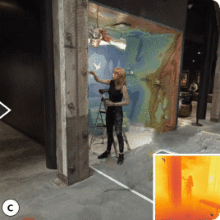Congratulations to Dieter Schmalstieg, Alexander von Humboldt Professor of Visual Computing, and colleagues. They received two awards for their work at this year's ISMAR conference.
Paper Impact Award
Dieter Schmalstieg and his co-author Daniel Wagner (Director, Snap Inc.) received the ISMAR Paper Impact Award for their joint publication "Experiences with Handheld Augmented Reality" (ISMAR 2007). The award recognizes publications for a particularly long-term impact within the research community and beyond.
Paper Abstract
In this paper, we present Studierstube ES, a framework for the development of handheld Augmented Reality. The applications run self-contained on handheld computers and smartphones with Windows CE. A detailed description of the performance critical tracking and rendering components are given. We also report on the implementation of a client-server architecture for multi-user applications, and a game engine for location based museum games that has been built on top of this infrastructure. Details on two games that were created, permanently deployed and evaluated in two Austrian museums illustrate the practical value of the framework and lessons learned from using it.
Paper Honorable Mention
The paper "Exemplar-Based Inpainting for 6DOF Virtual Reality Photos." was also successful. Shohei Mori (TU Graz), Dieter Schmalstieg and Denis Kalkofen (TU Graz) received a Best Paper Honorable Mention Award for their work.
Paper Abstract
Multi-layer images are currently the most prominent scene representation for viewing natural scenes under full-motion parallax in virtual reality. Layers ordered in diopter space contain color and transparency so that a complete image is formed when the layers are composited in a view-dependent manner. Once baked, the same limitations apply to multi-layer images as to conventional single-layer photography, making it challenging to remove obstructive objects or otherwise edit the content. Object removal before baking can benefit from filling disoccluded layers with pixels from background layers. However, if no such background pixels have been observed, an inpainting algorithm must fill the empty spots with fitting synthetic content. We present and study a multi-layer inpainting approach that addresses this problem in two stages: First, a volumetric area of interest specified by the user is classified with respect to whether the background pixels have been observed or not. Second, the unobserved pixels are filled with multi-layer inpainting. We report on experiments using multiple variants of multi-layer inpainting and compare our solution to conventional inpainting methods that consider each layer individually.
About ISMAR 2023
The 22nd IEEE International Symposium on Mixed and Augmented Reality (ISMAR) took place on October 16-20 as a hybrid conference in Sydney, Australia. Each year, ISMAR brings together leading researchers from the fields of augmented reality (AR), mixed reality (MR) and virtual reality. The conference includes two days of workshops, tutorials and competitions and three days of presentations of scientific papers, posters and demonstrations.


